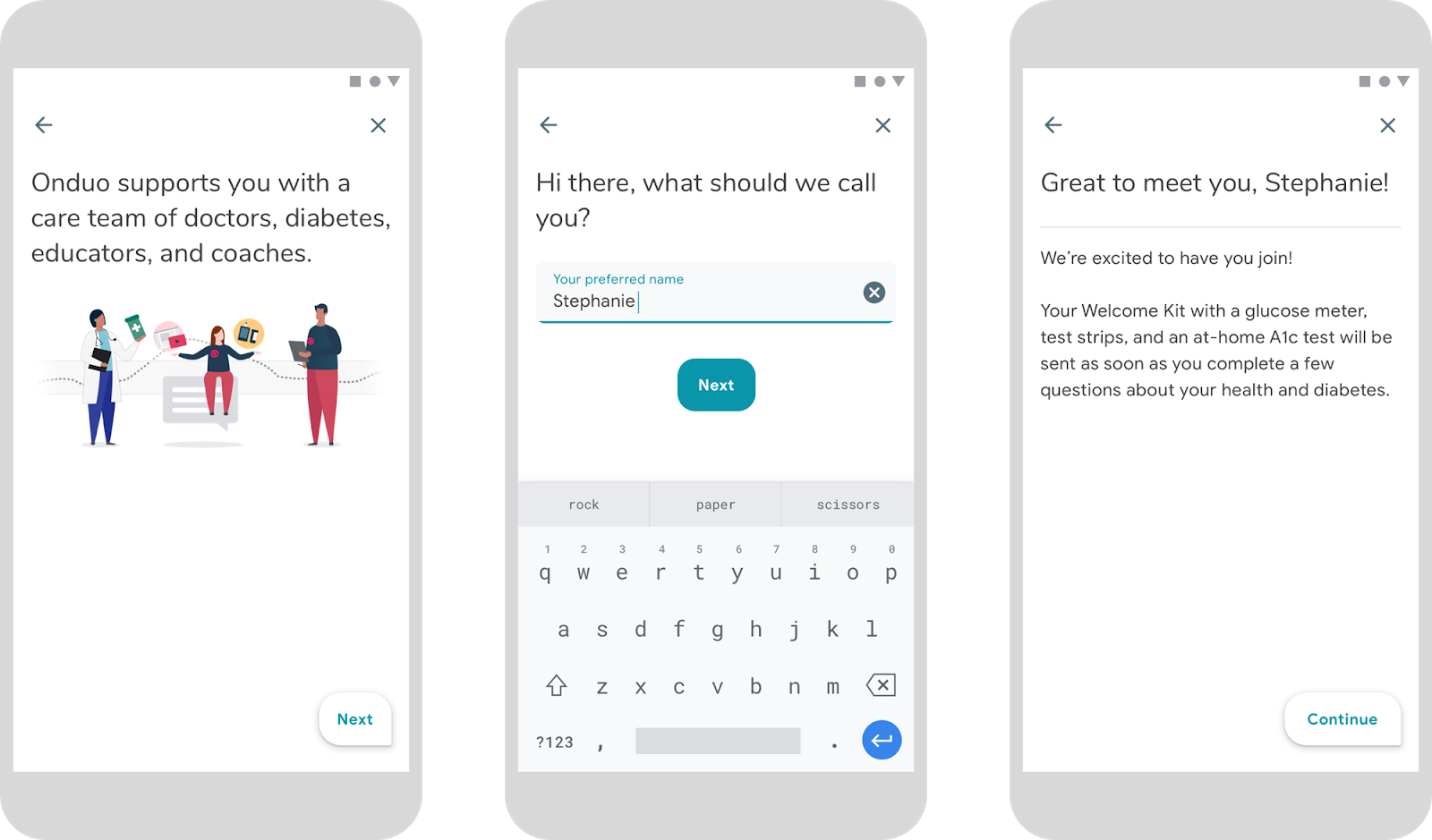Redesigning participant onboarding to put the user first
Reimagining the participant experience for people with type 2 diabetes.
This is the third blog post in the series of user experience focused blogs. Delivering great user experiences (UX) for the products and services we create is a guiding principle for our work at Verily. As a company, we start with user needs as we conceive and build our products. The Verily UX team (VUX) collaborates closely with multidisciplinary teams across our organization and is dedicated to understanding user needs via user research and delivering designs that address those needs in a safe, effective, and delightful way. This third post in our UX series focuses on our efforts to improve the medical history intake process when onboarding a new program participant onto Onduo, our virtual type 2 diabetes management program. Onduo is a joint venture between Verily and Sanofi.
A typical visit to a doctor’s office starts with a faded copy of an intake form that asks a number of questions about your past medical history. The questions may seem only remotely related to the visit you’re about to have. Then, you hand the intake form over and it seems to disappear on your way to the patients’ room, where the nurse or medical assistant may ask many of the same questions again.
At Verily, we, the user experience team, are supporting Onduo’s goals to reimagine the participant experience for people with type 2 diabetes. No more sterile environments. No more waiting for doctors who are running behind schedule. No more impersonal interactions. And, it all starts with that first impression. We know that first impressions can be formed within the first few seconds of an interaction, and their impact can last well beyond those initial moments. With this in mind, we knew that we had to start our app-experience (our first impression) off right. Before proceeding down the standard route of endless questionnaires, we took a step back asked ourselves: What would this look like if users were the primary focus?
First, we needed to thoroughly understand the needs of our care team who would ultimately use this information to create a care plan for the participant. Onduo’s goal is to provide support for people living with type 2 diabetes and this requires an understanding of our participants’ medical history and starting place so that we can offer support tailored to them.
Next, we wanted to ensure that our participants felt excited and eager to move forward with Onduo after completing the introductory period. To accomplish this goal, we turned to decades of behavioral science research on ways to empower and motivate patients in their care journey. This gave us a solid foundation to build upon. We came up with three main goals we wanted to achieve regarding how our users felt:
- We want program participants to feel in control and to understand why we ask the information that we do,
- We want them to feel competent and empowered to be advocates for their own health, and
- We want them to feel supported and heard.
After gaining this foundational understanding, we created initial ideas and prototypes of this new type of onboarding experience and tested them with target users. Feedback from the users helped us understand what was and wasn’t working—and after several rounds of iteration, we got to where we are today.
Before diving into the medical history, the Onduo app starts a conversation with the participant. The aim is to set the tone right. With a simple and rather informal ask ‘What should we call you?’, we set the tone right away. We use the participant’s preferred name throughout the onboarding process and pass that information on to their care team. This helps the participant feel that we’re listening.

Next, we set expectations for what our participants can count on us for. Taking their care out of the black box and laying it out explicitly helps participants feel in control.

Once we dive into the questions, we make sure participants feel heard and feel like we are making good use of their time. We always explain how the information they are providing, and the time they are giving us, will ultimately help us give them the support they need. If we can’t justify the why to the participant, then we know it’s not worth asking.
We want the participant to feel supported and heard. We do that in several ways. We acknowledge the difficulties of managing diabetes rather than brushing them under the rug. We use familiar and warmer language like “we.” This shows that while the participant is the agent of change, no one succeeds alone. The personal touch and feeling of connection are especially important when a large part of our care happens virtually.

The Results
Our new approach to onboarding resulted in an experience that not only works better as measured by the number of participants who successfully go through the flow, but more importantly, one that makes participants feel good about the journey they are about to start.
“It made me feel good to know that not everybody is lumped into one,” a participant said. “We’re all unique. We have different wants and needs.”Another participant said, “Sometimes surveys are so long and I get disinterested. This didn’t take that long.”A diabetes coach said, “I feel like I can do my job and focus on what I am best at.”
With feedback like that, we know we’re on the right track. However, the work is not done. We are continuously learning from participants about how to make the next iteration of the onboarding experience even better.
